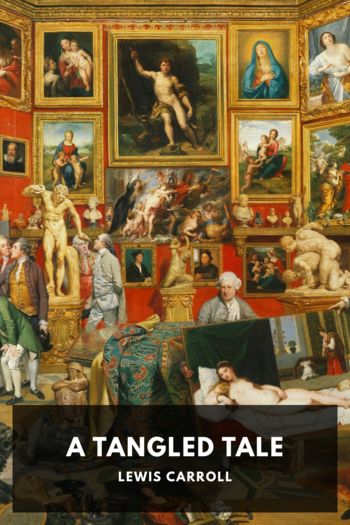A Tangled Tale, Lewis Carroll [free ebook novel .txt] 📗

- Author: Lewis Carroll
Book online «A Tangled Tale, Lewis Carroll [free ebook novel .txt] 📗». Author Lewis Carroll
In the following Class-list, I hope the solitary occupant of III will sheathe her claws when she hears how narrow an escape she has had of not being named at all. Her account of the process by which she got the answer is so meagre that, like the nursery tale of “Jack-a-Minory” (I trust I. E. A. will be merciful to the spelling), it is scarcely to be distinguished from “zero.”
Class List.
Guy.
Old Cat.
Sea-Breeze.
Ayr.
Bradshaw of the Future.
F. Lee.
H. Vernon.
Cat.
Answers to Knot VIProblem 1.—A and B began the year with only £1,000 apiece. They borrowed nought; they stole nought. On the next New-Year’s Day they had £60,000 between them. How did they do it?
Solution.—They went that day to the Bank of England. A stood in front of it, while B went round and stood behind it.
Two answers have been received, both worthy of much honour. Addlepate makes them borrow “0” and steal “0,” and uses both ciphers by putting them at the right-hand end of the £1,000, thus producing £100,000, which is well over the mark. But (or to express it in Latin) At Spes infracta has solved it even more ingeniously: with the first cipher she turns the “1” of the £1,000 into a “9,” and adds the result to the original sum, thus getting £10,000: and in this, by means of the other “0,” she turns the “1” into a “6,” thus hitting the exact £60,000.
Class List.
At Spes Infracta.
Addlepate.
Problem 2.—L makes 5 scarves, while M makes 2: Z makes 4 while L makes 3. Five scarves of Z’s weigh one of L’s; 5 of M’s weigh 3 of Z’s. One of M’s is as warm as 4 of Z’s: and one of L’s as warm as 3 of M’s. Which is best, giving equal weight in the result to rapidity of work, lightness, and warmth?
Answer.—The order is M, L, Z.
Solution.—As to rapidity (other things being constant) L’s merit is to M’s in the ratio of 5 to 2: Z’s to L’s in the ratio of 4 to 3. In order to get one set of 3 numbers fulfilling these conditions, it is perhaps simplest to take the one that occurs twice as unity, and reduce the others to fractions: this gives, for L, M, and Z, the marks 1, ⅖, ⅔. In estimating for lightness, we observe that the greater the weight, the less the merit, so that Z’s merit is to L’s as 5 to 1. Thus the marks for lightness are ⅕, ⅔, 1. And similarly, the marks for warmth are 3, 1, ¼. To get the total result, we must multiply L’s 3 marks together, and do the same for M and for Z. The final numbers are 1×15×3, 25×23×1, 23×1×14; i.e. ⅗, ⅔, ⅓; i.e. multiplying throughout by 15 (which will not alter the proportion), 9, 10, 5; showing the order of merit to be M, L, Z.
Twenty-nine answers have been received, of which five are right, and twenty-four wrong. These hapless ones have all (with three exceptions) fallen into the error of adding the proportional numbers together, for each candidate, instead of multiplying. Why the latter is right, rather than the former, is fully proved in textbooks, so I will not occupy space by stating it here: but it can be illustrated very easily by the case of length, breadth, and depth. Suppose A and B are rival diggers of rectangular tanks: the amount of work done is evidently measured by the number of cubical feet dug out. Let A dig a tank 10 feet long, 10 wide, 2 deep: let B dig one 6 feet long, 5 wide, 10 deep. The cubical contents are 200, 300; i.e. B is best digger in the ratio of 3 to 2. Now try marking for length, width, and depth, separately; giving a maximum mark of 10 to the best in each contest, and then adding the results!
Of the twenty-four malefactors, one gives no working, and so has no real claim





Comments (0)